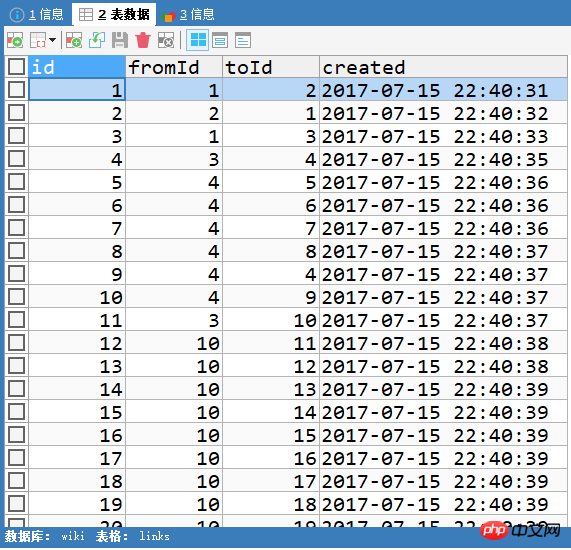Python网络数据采集3-数据存到CSV以及MySql
先热热身,下载某个页面的所有图片。
import requestsfrom bs4 import BeautifulSoup
headers = {'User-Agent': 'Mozilla/5.0 (Windows NT 10.0; Win64; x64) AppleWebKit/537.36 (KHTML, like Gecko)' ' Chrome/52.0.2743.116 Safari/537.36 Edge/15.16193'}
start_url = 'https://www.pythonscraping.com'r = requests.get(start_url, headers=headers)
soup = BeautifulSoup(r.text, 'lxml')# 获取所有img标签img_tags = soup.find_all('img')for tag in img_tags:print(tag['src'])http://pythonscraping.com/img/lrg%20(1).jpg
将网页表格存储到CSV文件中
以这个网址为例,有好几个表格,我们对第一个表格进行爬取。Wiki-各种编辑器的比较
import csvimport requestsfrom bs4 import BeautifulSoup
headers = {'User-Agent': 'Mozilla/5.0 (Windows NT 10.0; Win64; x64) AppleWebKit/537.36 (KHTML, like Gecko)' ' Chrome/52.0.2743.116 Safari/537.36 Edge/15.16193'}
url = 'https://en.wikipedia.org/wiki/Comparison_of_text_editors'r = requests.get(url, headers=headers)
soup = BeautifulSoup(r.text, 'lxml')# 只要第一个表格rows = soup.find('table', class_='wikitable').find_all('tr')# csv写入时候每写一行会有一空行被写入,所以设置newline为空with open('editors.csv', 'w', newline='', encoding='utf-8') as f:
writer = csv.writer(f)for row in rows:
csv_row = []for cell in row.find_all(['th', 'td']):
csv_row.append(cell.text)
writer.writerow(csv_row)需要注意的有一点,打开文件的时候需要指定newline='',因为写入csv文件时,每写入一行就会有一空行被写入。

从网络读取CSV文件
上面介绍了将网页内容存到CSV文件中。如果是从网上获取到了CSV文件呢?我们不希望下载后再从本地读取。但是网络请求的话,返回的是字符串而非文件对象。csv.reader()需要传入一个文件对象。故需要将获取到的字符串转换成文件对象。Python的内置库,StringIO和BytesIO可以将字符串/字节当作文件一样来处理。对于csv模块,要求reader迭代器返回字符串类型,所以使用StringIO,如果处理二进制数据,则用BytesIO。转换为文件对象,就能用CSV模块处理了。
下面的代码最为关键的就是data_file = StringIO(csv_data.text)将字符串转换为类似文件的对象。
from io import StringIOimport csvimport requests csv_data = requests.get('http://pythonscraping.com/files/MontyPythonAlbums.csv') data_file = StringIO(csv_data.text) reader = csv.reader(data_file)for row in reader:print(row)
['Name', 'Year'] ["Monty Python's Flying Circus", '1970'] ['Another Monty Python Record', '1971'] ["Monty Python's Previous Record", '1972'] ['The Monty Python Matching Tie and Handkerchief', '1973'] ['Monty Python Live at Drury Lane', '1974'] ['An Album of the Soundtrack of the Trailer of the Film of Monty Python and the Holy Grail', '1975'] ['Monty Python Live at City Center', '1977'] ['The Monty Python Instant Record Collection', '1977'] ["Monty Python's Life of Brian", '1979'] ["Monty Python's Cotractual Obligation Album", '1980'] ["Monty Python's The Meaning of Life", '1983'] ['The Final Rip Off', '1987'] ['Monty Python Sings', '1989'] ['The Ultimate Monty Python Rip Off', '1994'] ['Monty Python Sings Again', '2014']
DictReader可以像操作字典那样获取数据,把表的第一行(一般是标头)作为key。可访问每一行中那个某个key对应的数据。
每一行数据都是OrderDict,使用Key可访问。看上面打印信息的第一行,说明由Name和Year两个Key。也可以使用reader.fieldnames查看。
from io import StringIOimport csvimport requests csv_data = requests.get('http://pythonscraping.com/files/MontyPythonAlbums.csv') data_file = StringIO(csv_data.text) reader = csv.DictReader(data_file)# 查看Keyprint(reader.fieldnames)for row in reader:print(row['Year'], row['Name'], sep=': ')
['Name', 'Year'] 1970: Monty Python's Flying Circus 1971: Another Monty Python Record 1972: Monty Python's Previous Record 1973: The Monty Python Matching Tie and Handkerchief 1974: Monty Python Live at Drury Lane 1975: An Album of the Soundtrack of the Trailer of the Film of Monty Python and the Holy Grail 1977: Monty Python Live at City Center 1977: The Monty Python Instant Record Collection 1979: Monty Python's Life of Brian 1980: Monty Python's Cotractual Obligation Album 1983: Monty Python's The Meaning of Life 1987: The Final Rip Off 1989: Monty Python Sings 1994: The Ultimate Monty Python Rip Off 2014: Monty Python Sings Again
存储数据
大数据存储与数据交互能力, 在新式的程序开发中已经是重中之重了.
存储媒体文件的2种主要方式: 只获取url链接, 或直接将源文件下载下来
直接引用url链接的优点:
爬虫运行得更快,耗费的流量更少,因为只要链接,不需要下载文件。
可以节省很多存储空间,因为只需要存储 URL 链接就可以。
存储 URL 的代码更容易写,也不需要实现文件下载代码。
不下载文件能够降低目标主机服务器的负载。
直接引用url链接的缺点:
这些内嵌在网站或应用中的外站 URL 链接被称为盗链(hotlinking), 每个网站都会实施防盗链措施。
因为链接文件在别人的服务器上,所以应用就要跟着别人的节奏运行了。
盗链是很容易改变的。如果盗链图片放在博客上,要是被对方服务器发现,很可能被恶搞。如果 URL 链接存起来准备以后再用,可能用的时候链接已经失效了,或者是变成了完全无关的内容。
python3的urllib.request.urlretrieve可以根据文件的url下载文件:
from urllib.request import urlretrievefrom urllib.request import urlopenfrom bs4 import BeautifulSouphtml = urlopen("http://www.pythonscraping.com")bsObj = BeautifulSoup(html)imageLocation = bsObj.find("a", {"id": "logo"}).find("img")["src"]urlretrieve (imageLocation, "logo.jpg")
csv(comma-separated values, 逗号分隔值)是存储表格数据的常用文件格式
网络数据采集的一个常用功能就是获取html表格并写入csv
除了用户定义的变量名,mysql是不区分大小写的, 习惯上mysql关键字用大写表示
连接与游标(connection/cursor)是数据库编程的2种模式:
连接模式除了要连接数据库之外, 还要发送数据库信息, 处理回滚操作, 创建游标对象等
一个连接可以创建多个游标, 一个游标跟踪一种状态信息, 比如数据库的使用状态. 游标还会包含最后一次查询执行的结果. 通过调用游标函数, 如fetchall获取查询结果
游标与连接使用完毕之后,务必要关闭, 否则会导致连接泄漏, 会一直消耗数据库资源
使用try ... finally语句保证数据库连接与游标的关闭
让数据库更高效的几种方法:
给每张表都增加id字段. 通常数据库很难智能地选择主键
用智能索引, CREATE INDEX definition ON dictionary (id, definition(16));
选择合适的范式
发送Email, 通过爬虫或api获取信息, 设置条件自动发送Email! 那些订阅邮件, 肯定就是这么来的!

保存链接之间的联系
比如链接A,能够在这个页面里找到链接B。则可以表示为A -> B。我们就是要保存这种联系到数据库。先建表:
pages表只保存链接url。
CREATE TABLE `pages` ( `id` int(11) NOT NULL AUTO_INCREMENT, `url` varchar(255) DEFAULT NULL, `created` timestamp NOT NULL DEFAULT CURRENT_TIMESTAMP, PRIMARY KEY (`id`) )
links表保存链接的fromId和toId,这两个id和pages里面的id是一致的。如1 -> 2就是pages里id为1的url页面里可以访问到id为2的url的意思。
CREATE TABLE `links` ( `id` int(11) NOT NULL AUTO_INCREMENT, `fromId` int(11) DEFAULT NULL, `toId` int(11) DEFAULT NULL, `created` timestamp NOT NULL DEFAULT CURRENT_TIMESTAMP, PRIMARY KEY (`id`)
上面的建表语句看起来有点臃肿,我是先用可视化工具建表后,再用show create table pages这样的语句查看的。
import reimport pymysqlimport requestsfrom bs4 import BeautifulSoup
headers = {'User-Agent': 'Mozilla/5.0 (Windows NT 10.0; Win64; x64) AppleWebKit/537.36 (KHTML, like Gecko)' ' Chrome/52.0.2743.116 Safari/537.36 Edge/15.16193'}
conn = pymysql.connect(host='localhost', user='root', password='admin', db='wiki', charset='utf8')
cur = conn.cursor()def insert_page_if_not_exists(url):
cur.execute(f"SELECT * FROM pages WHERE url='{url}';")# 这条url没有插入的话if cur.rowcount == 0:# 那就插入cur.execute(f"INSERT INTO pages(url) VALUES('{url}');")
conn.commit()# 刚插入数据的idreturn cur.lastrowid# 否则已经存在这条数据,因为url一般是唯一的,所以获取一个就行,取脚标0是获得idelse:return cur.fetchone()[0]def insert_link(from_page, to_page):print(from_page, ' -> ', to_page)
cur.execute(f"SELECT * FROM links WHERE fromId={from_page} AND toId={to_page};")# 如果查询不到数据,则插入,插入需要两个pages的id,即两个urlif cur.rowcount == 0:
cur.execute(f"INSERT INTO links(fromId, toId) VALUES({from_page}, {to_page});")
conn.commit()# 链接去重pages = set()# 得到所有链接def get_links(page_url, recursion_level):global pagesif recursion_level == 0:return# 这是刚插入的链接page_id = insert_page_if_not_exists(page_url)
r = requests.get('https://en.wikipedia.org' + page_url, headers=headers)
soup = BeautifulSoup(r.text, 'lxml')
link_tags = soup.find_all('a', href=re.compile('^/wiki/[^:/]*$'))for link_tag in link_tags:# page_id是刚插入的url,参数里再次调用了insert_page...方法,获得了刚插入的url里能去往的url列表# 由此形成联系,比如刚插入的id为1,id为1的url里能去往的id有2、3、4...,则形成1 -> 2, 1 -> 3这样的联系insert_link(page_id, insert_page_if_not_exists(link_tag['href']))if link_tag['href'] not in pages:
new_page = link_tag['href']
pages.add(new_page)# 递归查找, 只能递归recursion_level次get_links(new_page, recursion_level - 1)if __name__ == '__main__':try:
get_links('/wiki/Kevin_Bacon', 5)except Exception as e:print(e)finally:
cur.close()
conn.close()1 -> 2 2 -> 1 1 -> 2 1 -> 3 3 -> 4 4 -> 5 4 -> 6 4 -> 7 4 -> 8 4 -> 4 4 -> 4 4 -> 9 4 -> 9 3 -> 10 10 -> 11 10 -> 12 10 -> 13 10 -> 14 10 -> 15 10 -> 16 10 -> 17 10 -> 18 10 -> 19 10 -> 20 10 -> 21 ...
看打印的信息,一目了然。看前两行打印,pages表里id为1的url可以访问id为2的url,同时pages表里id为2的url可以访问id为1的url...依次类推。
首先需要使用insert_page_if_not_exists(page_url)获得链接的id,然后使用insert_link(fromId, toId)形成联系。fromId是当前页面的url,toId则是从当前页面能够去往的url的id,这些能去往的url用bs4找到以列表形式返回。当前所处的url即page_id,所以需要在insert_link的第二个参数中,再次调用insert_page_if_not_exists(link)以获得列表中每个url的id。由此形成了联系。比如刚插入的id为1,id为1的url里能去往的id有2、3、4...,则形成1 -> 2, 1 -> 3这样的联系。
看下数据库。下面是pages表,每一个id都对应一个url。

然后下面是links表,fromId和toId就是pages中的id。当然和打印的数据是一样的咯,不过打印了看看就过去了,存下来的话哪天需要分析这些数据就大有用处了。

以上是Python采集--数据的储存的详细内容。更多信息请关注PHP中文网其他相关文章!
 了解差异:用于循环和python中的循环May 16, 2025 am 12:17 AM
了解差异:用于循环和python中的循环May 16, 2025 am 12:17 AMtheDifferenceBetweewneaforoopandawhileLoopInpythonisthataThataThataThataThataThataThataNumberoFiterationSiskNownInAdvance,而leleawhileLoopisusedWhenaconDitionNeedneedneedneedNeedStobeCheckedStobeCheckedStobeCheckedStobeCheckedStobeceDrepeTysepectients.peatsiveSectlyStheStobeCeptellyWithnumberofiterations.1)forloopsareAceareIdealForitoringercortersence
 Python循环控制:对于vs -a -a比较May 16, 2025 am 12:16 AM
Python循环控制:对于vs -a -a比较May 16, 2025 am 12:16 AM在Python中,for循环适用于已知迭代次数的情况,而while循环适合未知迭代次数且需要更多控制的情况。1)for循环适用于遍历序列,如列表、字符串等,代码简洁且Pythonic。2)while循环在需要根据条件控制循环或等待用户输入时更合适,但需注意避免无限循环。3)性能上,for循环略快,但差异通常不大。选择合适的循环类型可以提高代码的效率和可读性。
 如何在Python中结合两个列表:5种简单的方法May 16, 2025 am 12:16 AM
如何在Python中结合两个列表:5种简单的方法May 16, 2025 am 12:16 AM在Python中,可以通过五种方法合并列表:1)使用 运算符,简单直观,适用于小列表;2)使用extend()方法,直接修改原列表,适用于需要频繁更新的列表;3)使用列表解析式,简洁且可对元素进行操作;4)使用itertools.chain()函数,内存高效,适合大数据集;5)使用*运算符和zip()函数,适用于需要配对元素的场景。每种方法都有其特定用途和优缺点,选择时应考虑项目需求和性能。
 循环时循环:python语法,用例和示例May 16, 2025 am 12:14 AM
循环时循环:python语法,用例和示例May 16, 2025 am 12:14 AMforoopsare whenthenemberofiterationsisknown,而whileLoopsareUseduntilacTitionismet.1)ForloopSareIdealForeSequencesLikeLists,UsingSyntaxLike'forfruitinFruitinFruitinFruitIts:print(fruit)'。2)'
 python串联列表列表May 16, 2025 am 12:08 AM
python串联列表列表May 16, 2025 am 12:08 AMtoConcateNateAlistofListsInpython,useextend,listComprehensions,itertools.Chain,orrecursiveFunctions.1)ExtendMethodStraightForwardButverBose.2)listComprechencomprechensionsareconconconciseandemandeconeandefforlargerdatasets.3)
 Python中的合并列表:选择正确的方法May 14, 2025 am 12:11 AM
Python中的合并列表:选择正确的方法May 14, 2025 am 12:11 AMTomergelistsinpython,YouCanusethe操作员,estextMethod,ListComprehension,Oritertools
 如何在Python 3中加入两个列表?May 14, 2025 am 12:09 AM
如何在Python 3中加入两个列表?May 14, 2025 am 12:09 AM在Python3中,可以通过多种方法连接两个列表:1)使用 运算符,适用于小列表,但对大列表效率低;2)使用extend方法,适用于大列表,内存效率高,但会修改原列表;3)使用*运算符,适用于合并多个列表,不修改原列表;4)使用itertools.chain,适用于大数据集,内存效率高。
 Python串联列表字符串May 14, 2025 am 12:08 AM
Python串联列表字符串May 14, 2025 am 12:08 AM使用join()方法是Python中从列表连接字符串最有效的方法。1)使用join()方法高效且易读。2)循环使用 运算符对大列表效率低。3)列表推导式与join()结合适用于需要转换的场景。4)reduce()方法适用于其他类型归约,但对字符串连接效率低。完整句子结束。


热AI工具

Undresser.AI Undress
人工智能驱动的应用程序,用于创建逼真的裸体照片

AI Clothes Remover
用于从照片中去除衣服的在线人工智能工具。

Undress AI Tool
免费脱衣服图片

Clothoff.io
AI脱衣机

Video Face Swap
使用我们完全免费的人工智能换脸工具轻松在任何视频中换脸!

热门文章

热工具

MinGW - 适用于 Windows 的极简 GNU
这个项目正在迁移到osdn.net/projects/mingw的过程中,你可以继续在那里关注我们。MinGW:GNU编译器集合(GCC)的本地Windows移植版本,可自由分发的导入库和用于构建本地Windows应用程序的头文件;包括对MSVC运行时的扩展,以支持C99功能。MinGW的所有软件都可以在64位Windows平台上运行。

SublimeText3 Mac版
神级代码编辑软件(SublimeText3)

SublimeText3 Linux新版
SublimeText3 Linux最新版

EditPlus 中文破解版
体积小,语法高亮,不支持代码提示功能

DVWA
Damn Vulnerable Web App (DVWA) 是一个PHP/MySQL的Web应用程序,非常容易受到攻击。它的主要目标是成为安全专业人员在合法环境中测试自己的技能和工具的辅助工具,帮助Web开发人员更好地理解保护Web应用程序的过程,并帮助教师/学生在课堂环境中教授/学习Web应用程序安全。DVWA的目标是通过简单直接的界面练习一些最常见的Web漏洞,难度各不相同。请注意,该软件中






